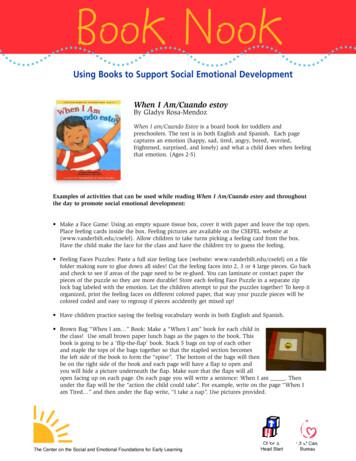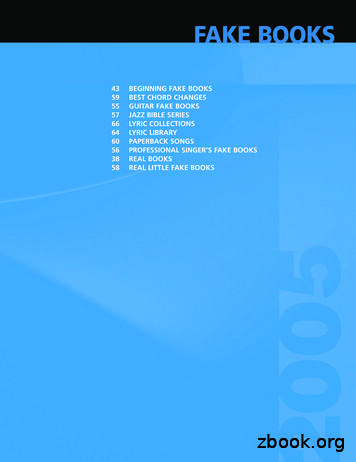Using Books To Support Social Emotional Development
Book NookUsing Books to Support Social Emotional DevelopmentWhen I Am/Cuando estoyBy Gladys Rosa-MendozWhen I am/Cuando Estoy is a board book for toddlers andpreschoolers. The text is in both English and Spanish. Each pagecaptures an emotion (happy, sad, tired, angry, bored, worried,frightened, surprised, and lonely) and what a child does when feelingthat emotion. (Ages 2-5)Examples of activities that can be used while reading When I Am/Cuando estoy and throughoutthe day to promote social emotional development: Make a Face Game: Using an empty square tissue box, cover it with paper and leave the top open.Place feeling cards inside the box. Feeling pictures are available on the CSEFEL website at(www.vanderbilt.edu/csefel). Allow children to take turns picking a feeling card from the box.Have the child make the face for the class and have the children try to guess the feeling. Feeling Faces Puzzles: Paste a full size feeling face (website: www.vanderbilt.edu/csefel) on a filefolder making sure to glue down all sides! Cut the feeling faces into 2, 3 or 4 large pieces. Go backand check to see if areas of the page need to be re-glued. You can laminate or contact paper thepieces of the puzzle so they are more durable! Store each feeling Face Puzzle in a separate ziplock bag labeled with the emotion. Let the children attempt to put the puzzles together! To keep itorganized, print the feeling faces on different colored paper, that way your puzzle pieces will becolored coded and easy to regroup if pieces accidently get mixed up! Have children practice saying the feeling vocabulary words in both English and Spanish. Brown Bag “When I am ” Book: Make a “When I am” book for each child inthe class! Use small brown paper lunch bags as the pages to the book. Thisbook is going to be a ‘flip-the-flap’ book. Stack 5 bags on top of each otherand staple the tops of the bags together so that the stapled section becomesthe left side of the book to form the “spine”. The bottom of the bags will thenbe on the right side of the book and each page will have a flap to open andyou will hide a picture underneath the flap. Make sure that the flaps will allopen facing up on each page. On each page you will write a sentence: When I am . Thenunder the flap will be the “action the child could take”. For example, write on the page “When Iam Tired ” and then under the flap write, “I take a nap”. Use pictures provided.The Center on the Social and Emotional Foundations for Early LearningOffice ofHead StartChild CareBureau
Book NookReading the same book for several days in a row is a great way to provide opportunities for infants,toddlers, and preschoolers to develop a sense of competence and confidence, which is an importantpart of social and emotional development. They learn to turn pages, point to and label pictures,talk about the story, predict what will happen next, learn new vocabulary words, talk about their ownexperiences in relation to the story and even make up their own story! Try reading When I Am/Cuandoestoy for several days in a row and use some of the ideas, activities, and teaching opportunities listedbelow to enhance social and emotional skills.FeelingsArrival:Feeling Check in Chart: As the children are arriving to school, have them checkin by telling you how they feel. See picture samples. (Feeling pictures availableon the CSEFEL website at www.vanderbilt.edu/csefel.) Make a clothes-pin foreach child with the child’s photograph and name pasted onto the side. As thechildren arrive each day, help each child take their close-pin to the feeling chartand attach it to how they are feeling that morning. You could also makepersonalized individual charts by using the “this is how I feel poster” on theCSEFEL website and place Velcro next to each feeling face and allow the childrento Velcro their individual picture next to the emotion that they are feeling.Note: Feelings can change through out the day. Remind the children that even ifthey were sad when they arrived to school, that they might be happier later. If achild’s feeling changes, then help him/her back to the feeling chart and assist inchanging his/her name to the new feeling.Circle:I See Me Mirror Play: While re-reading the story, have each child hold a mirror. As you read eachpage have the children practice making their happy, sad, tired, angry, bored, worried, frightened,surprised, and lonely face to match the children’s expressions in the book.Feeling Song: Sing a song that discusses feeling. To the tune of Happy Birthday sing:When I’m happy, I smile. When I’m happy, I smile. When I’m happy, I smile. When I’m happy, I smile.When I’m sad, I frown When I’m mad, I scowl When I’m tired, I sleep When I’m bored, I find a friend When I’m worried, I talk to mom (or dad) When I’m frightened, my heart beats fast. When I’m frightened, my heart beats fast. When I’mfrightened, my heart beats fast; and I hug my teacher.When I’m surprised, I open my mouth. When I’m surprised, I open my mouth. When I’m surprised,I open my mouth; and take a deep breath.When I’m lonely, I find a friend
Book NookCenters:Library: Classroom Feeling Book—Make a feeling book that includes pictures of the children in yourclass. Have children act out a different feeling and take a photograph of it. Paste the photograph to afile folder (several file folders can be combined together to form a durable book by punching holes onthe fold and stringing them together to form a spine). Some possible photograph opportunities to addin your book could be: take a picture of a child smiling on the playground while a friend pusheshim/her on the swing and add a caption: I am happy when my friend helps me swing; take a picture ofchildren in the rocking boat together and laughing and add a caption to the book: I laugh with myfriend in the rocking boat; when a child cries after falling down, snap a picture and write a caption (ofcourse, only do this if your camera is immediately available and ask the child if it’s ok to take theirpicture): I cry when I get a boo boo; etc.Outside Play:Draw feeling faces on rubber balls. Then ask a child to:Throw the mad ball to a friend.Kick the happy ball to a friend.Put the tired ball in the basket.Pass the sad ball to a friend.Art:Paper Collage: Have children cut out different feeling faces from magazines. Mix non-toxic glue andwater together in a small bowl. Let the children put the pictures on top of a piece of paper and thentake a paint brush and dip it in the glue solution and paint over their pictures covering them with theglue solution. The children can then hang up their collage of different feelings faces.Snack Time:Snack-able Faces: Talk about “when I am hungry; I eat.” And “when I am thirsty; I drink.” Let’s makesnack fun! Use crackers, Oreos, peanut butter, raisins, small marshmallows, stick pretzels, and anyother foods that you can make faces with. Let the children design different faces and then eat them.Talk about each emotion while they are designing them. If needed, have the feeling face cards availableto look at and have the children try to copy the expressions.Nap Time:When I am Tired: Talk about “when I am tired; I take a nap or I go night-night.” Relate being tired totaking a nap just like the child in the book. Have each child find a tired baby doll or stuffed animal totake to their nap area and have them try to help their tired “friend” take a nap.This Book Nook was developed by Anne Wimmer and Rochelle Lentini
To the tune of Happy Birthday sing: When I’m happy, I smile. When I’m happy, I smile. When I’m happy, I smile. When I’m happy, I smile. When I’m sad, I frown When I’m mad, I scowl When I’m tired, I sleep When I’m bored, I find a friend
FAKE BOOKS 43 BEGINNING FAKE BOOKS 59 BEST CHORD CHANGES 55 GUITAR FAKE BOOKS 57 JAZZ BIBLE SERIES 66 LYRIC COLLECTIONS 64 LYRIC LIBRARY 60 PAPERBACK SONGS 56 PROFESSIONAL SINGER’S FAKE BOOKS 38 REAL BOOKS 58 REAL LITTLE FAKE BOOKS. F A K E B O O K S 38 FAKE BOOKS The Real Books are the best-sel
work/products (Beading, Candles, Carving, Food Products, Soap, Weaving, etc.) ⃝I understand that if my work contains Indigenous visual representation that it is a reflection of the Indigenous culture of my native region. ⃝To the best of my knowledge, my work/products fall within Craft Council standards and expectations with respect to
Jerry Coker’s Books Lennie Niehaus Books Dr Frederick Tillis Jazz Improvisation Dr Willie Hill Books. Andy Jaffe’s Books. Oliver Nelson Patterns for Jazz Joseph Viola Saxophone Books. Can be adapted for any Instrument All the John Mehegan piano books Jamey Abersold offers one of the largest selections of books and resources for Jazz that I
THE OLD TESTAMENT 46 Books THE NEW TESTAMENT . BOOKS. THE 39 BOOKS OF THE OLD TESTAMENT The 5 Books of Moses 12 Historical Books 5 Poetic Books 5 Major Prophets 12 Minor Prophets 2nd Canon THE 7 DEUTRO-CANONICAL BOOKS . THE NEW TESTAMENT THE 27 BOOKS OF THE NEW TESTAMENT . The Gospels . PAULINE EPISTLES
Welcome to SCBWI’s Recommended Reading List, a premiere list comprised of books that were written and/or illustrated by our members during 2019. The List is organized into these categories: Board Books, Picture Books, Early Readers, Chapter Books, Middle Grade Books, Young Adult Books, and Anthologies. Within those categories, you can use the following keywords to search out books
There are science books and math books on a shelf. The ratio of the number of science books to the number of math books is 4 : 9. a) Find the ratio of the number of math books to the total number of books. b) What fraction of the books are sc
LexisNexis - Halsbury's Law of England 1 Total 74,513 (Table: 2) The table given below indicates the existing e‐book capacity in the library. Subscribed electronic books No of books ebrary 78,000 Hinari 46,000 ARDI books 19,000 OARE books 18,000 Upto date online 14,000 EBSCO e-books 6,000 AGORA books 5,800 Knovel 3,800 ProQuest e‐books 511
Grade 2 collected 25 books. Grade 3 collected 15 books. Grade 4 collected 10 books. The school had a book drive to support the local shelter. Grades 1, 2, 3, and 4 collected books. Organize the book data into the pictograph above. 1. Who collected the most books? _ 2. What was the total amount of books collected? _ 3. Which grade .






















